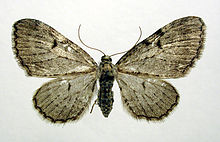
Eupithecia is the largest genus of moths of the family Geometridae, and the namesake and type genus of tribe Eupitheciini. Species in the genus are, like those of other genera in the tribe, commonly known as pugs. The genus is highly speciose, with over 1400 species, and members of the genus are present in most of the world with exception of Australasia. Roughly a quarter of described Eupithecia species occur in the Neotropical realm, where they have an especially high species diversity in the montane rain forests of the Andes. The genus includes a few agricultural pest species, such as the currant pug moth, Eupithecia assimilata, which is a pest on hops, and the cloaked pug moth, Eupithecia abietaria, which is a cone pest in spruce seed orchards.

Freyer's pug is a moth of the family Geometridae. The species can be found in Europe, east to the Urals, the Russian Far East, Kazakhstan and China. It is also found in North America.

The larch pug is a moth of the family Geometridae. The species can be found in Europe, the Ural Mountains, West and Central Siberia, the Altai Mountains, Transbaikalia, Yakutia, the Far East, Mongolia, Korea, Japan and in North America, from Yukon and Newfoundland to New York and Arizona.

Baptria is a monotypic moth genus in the family Geometridae erected by Jacob Hübner in 1825. Its only species, Baptria tibiale, was first described by Eugenius Johann Christoph Esper in 1791. It is found in central and northern Europe.

Eupithecia satyrata, the satyr pug, is a species of moth of the family Geometridae. It was described by Jacob Hübner in 1813. It is found from Ireland, through northern and central Europe east to all of Russia and central Asia and western Siberia to Tibet. It is also present in North Africa and North America.

Eupithecia groenblomi is a moth of the family Geometridae. It is known from Europe and Asia. In Europe, it occurs in Norway, Finland and northwestern Russia and the Urals. In Asia, it is known from the Russian Far East, the Kuril Islands, Japan and China.

Mesoptila melanolopha is a moth in the family Geometridae first described by Charles Swinhoe in 1895. It is found in Nepal, China, Korea, Japan, Taiwan, India, Sri Lanka, Thailand, Vietnam, Malaysia and on Java, Bali and Borneo.
Girida rigida is a moth in the family Geometridae first described by Charles Swinhoe in 1892. It is found from the Ryukyu Islands through tropical and subtropical south-east Asia to New Caledonia. Records for eastern Africa refer to Girida sporadica, which was promoted to species rank in 2012.
Eupithecia costipicta is a moth in the family Geometridae. It is found in Afghanistan, India (Sikkim) and China. The habitat consists of mountainous areas at altitudes between 2,300 and 3,500 meters.
Eupithecia amicula is a moth in the family Geometridae first described by Vladimir G. Mironov and Anthony Charles Galsworthy in 2005. It is found in south-western and western Chinese provinces of Sichuan, Yunnan and Shaanxi.

Eupithecia silenicolata is a moth in the family Geometridae. It is found from southern Europe and Morocco to western Asia, Iran and Pakistan. In the north, the range extends to southern Switzerland, Austria and northern Italy.
Eupithecia acolpodes is a moth in the family Geometridae. It is found in India and Pakistan. Vladimir Mironov and Anthony Galsworthy place the species as part of the sinuosaria species group.
Eupithecia propagata is a moth in the family Geometridae. It is found in India, Nepal, Bhutan and China. It is on wing from late July to late October.
Eupithecia dissertata is a moth in the family Geometridae found in Europe and Asia.
Eupithecia mesogrammata is a moth in the family Geometridae. It is found in Iran, Turkey and Georgia.
Pareupithecia is a genus of moths in the family Geometridae. It contains only one species, Pareupithecia spadix, which is found in the Russian Far East, Korea, Japan (Honshu) and Shanxi, China.
Eupithecia kuldschaensis is a moth in the family Geometridae. It is found in Mongolia, China and south-east Kazakhstan. It has been found at an altitude between 1200 and 2000 meters, and is on wing in a single generation from mid-June to mid-July.
Eupithecia infecta is a moth in the family Geometridae. It is found in China (Shensi).
Eupithecia lasciva is a moth in the family Geometridae. It is found in China, where it is known from Tibet, Qinghai, Gansu, Shanxi, Shaanxi, Sichuan, and Yunnan. In Yunnan, specimens have been collected at altitudes up to ca. 4500 meters. Adults are on wing in April, and again from mid-June to mid-September.
Eupithecia vana is a moth in the family Geometridae. It is found in China, where it is known from the Shaanxi and Henan provinces. The species is on wing from mid-April to mid-May, and again from early to late August.









